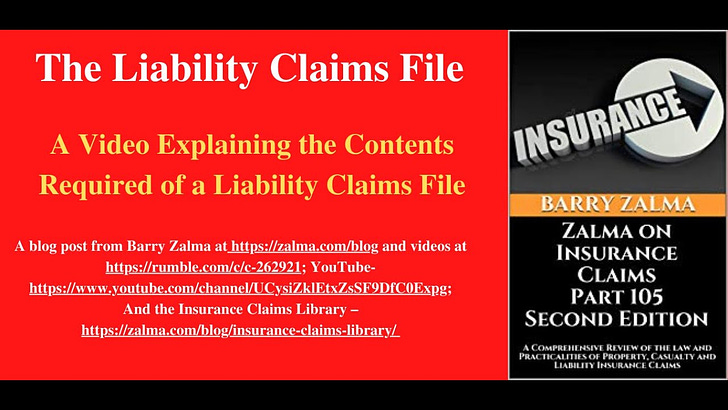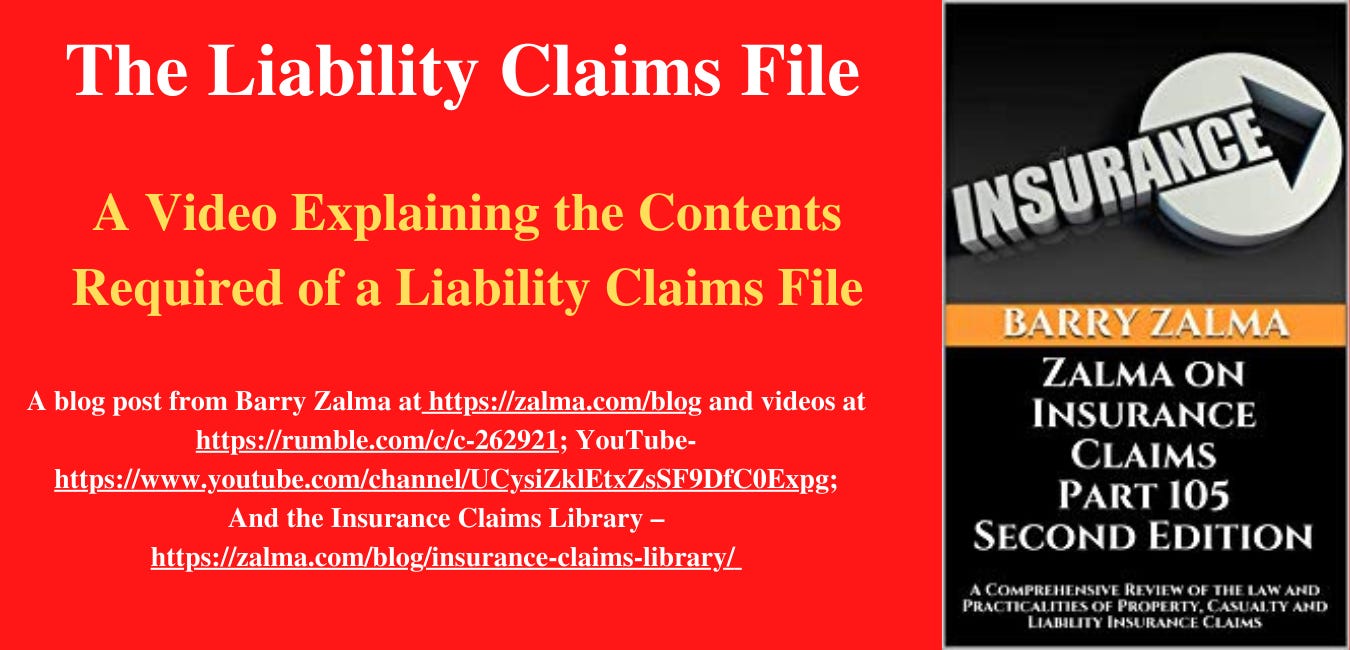Read the full article at https://www.linkedin.com/pulse/liability-claims-file-barry-zalma-esq-cfe and see the full video at https://rumble.com/c/c-262921; and at
and at https://zalma.com/blog plus more than 3850 posts.
The claim file is the basic foundation on which all claims are resolved. It is used by defense counsel to properly defend a claim. It is the source of all necessary information to make a reasoned decision with regard to a claim. An incomplete claim file is a danger to the insurer and its insured and is evidence of unprofessional claims handling. For all liability claims it is important to memorialize and record the facts as soon as possible after the incident.
Insurers have adopted computerized log notes so that claims personnel can record, but not erase, notes of the conduct day by day. They do so to allow supervision of the claims handlers, comply with the requirements of state regulators who are called upon to deal with complaints, and to be able to provide evidence that the claims investigation was conducted in good faith.
The Need for Photos
Photographs should be good quality, reproducible, and with a negative that can be enlarged or recorded digitally with at least sufficient density that the photos can be printed, enlarged or projected in high quality.
Publications
Newspapers published the day of, and the day after, the incident provide information regarding the weather on the date of the incident, the temperature, the time of sunrise and sunset, wind patterns, smog or visibility problems, and other information relating to the environmental context of the incident. Other local articles, magazines, or publications that provide an unbiased, objective view of weather, events, or other conditions that may have had a bearing on the incident can yield valuable insights.
Police, Governmental or Internal Security Reports
Copies of all reports made by any agency regarding the incident should be obtained.
Communications With Claimant & Witnesses
All contacts with each claimant should be specifically documented, including the dates that each contact took place, the time and place of the contact, who was present at the time of the contact, whether the contact was recorded by the adjuster and/or the claimant, and the physical condition of the claimant at the time of the contact. The adjuster should record observations of casts, canes, or walkers and their use by the claimant.
© 2021 – Barry Zalma Barry Zalma, Esq., CFE, now limits his practice to service as an insurance consultant specializing in insurance coverage, insurance claims handling, insurance bad faith and insurance fraud almost equally for insurers and policyholders.
He also serves as an arbitrator or mediator for insurance related disputes. He practiced law in California for more than 44 years as an insurance coverage and claims handling lawyer and more than 54 years in the insurance business.
He is available at
and zalma@zalma.com. Mr. Zalma is the first recipient of the first annual Claims Magazine/ACE Legend Award. Over the last 53 years Barry Zalma has dedicated his life to insurance, insurance claims and the need to defeat insurance fraud. He has created the following library of books and other materials to make it possible for insurers and their claims staff to become insurance claims professionals.
Go to the podcast Zalma On Insurance at https://anchor.fm/barry-zalma; Follow Mr. Zalma on Twitter at https://twitter.com/bzalma; Go to Barry Zalma videos at Rumble.com at https://rumble.com/c/c-262921; Go to Barry Zalma on YouTube- https://www.youtube.com/channel/UCysiZklEtxZsSF9DfC0Expg; Go to the Insurance Claims Library – https://zalma.com/blog/insurance-claims-library/ Read posts from Barry Zalma at https://parler.com/profile/Zalma/posts; and the last two issues of ZIFL at https://zalma.com/zalmas-insurance-fraud-letter-2/ podcast now available at https://podcasts.apple.com/us/podcast/zalma-on-insurance/id1509583809?uo=4






